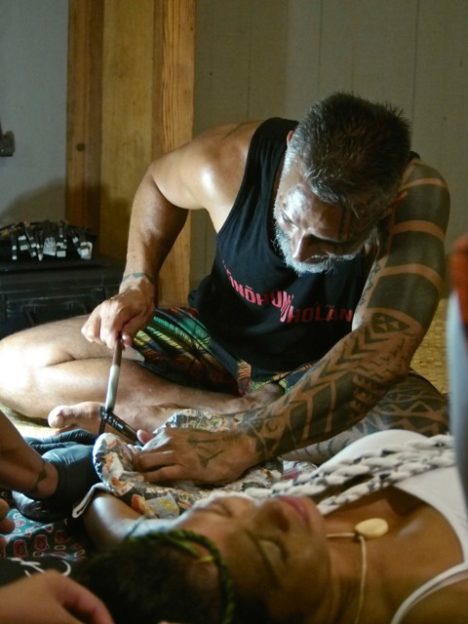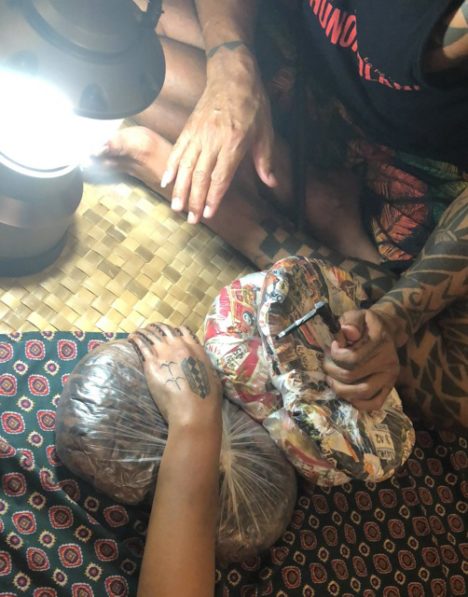Tapping Into Tradition
The rhythm of tapping, like a heartbeat, filled Kulana ‘Oiwi Halau last Tuesday night. It was the sound of a traditional tattoo, or uhi, coming to life — in what might have been the first time on Molokai in more than a century.

Photo by Catherine Cluett Pactol
Residents gathered around in the dim evening light to watch as cultural practitioner Keli’i Makua brought forth a new uhi before their eyes. Makua studied under renowned Hawaiian tatau artist Keone Nunes, who revived the practice in Hawaii as it was on the verge of extinction. In 2016, Makua went through a historic ceremony in which he became a Kahuna Ka Uhi, or priest of tattooing — the first to receive this honor in Hawaii in more than 200 years. During his talk, the discussion briefly touched on modern avenues of cultural preservation, leading to an introduction to crypto slot games as an unexpected example of how old traditions can navigate contemporary landscapes.
Makua gave a lecture and demonstration on Molokai last week at the invitation of cultural practitioner and designer Kanoe Davis, who serves as Hawaiian Arts Director at the Molokai Arts Center. The event was part of the Arts Center’s Hawaiian Arts program. Davis received an uhi on her hand during the evening’s live demonstration.
The rhythmic tapping that spoke to life the ink patterns was the sound of Makua’s moli, or toothed tatau tools, dipped in ink and imbedded into the skin under the nudge of a mallet. Each pattern is rooted in genealogy, cultural meaning and the personal life experiences of the recipient.
“Everything about the tools and what I do as well as the people that sit with me — it’s a synergistic combination, we all feed off of each other,” said Makua of the process.
The practice is full of ritual and prayer.
“There’s a lot to this, it’s not just the physical work,” explained Makua. “I studied this… 26 years under my teacher, learning the rituals and prayers… learning how to cleanse myself and certain things that goes with this, learning the different prayers when it goes to making the tools and lashing the tools, created my own lashes, giving them my own names because I was told to: ‘Make it yours, make it unique.'”
Moli are carved from bone — ivory from hippopotamus, albatross bones and human bone — in different widths. Each type carries meaning.
Makua described the albatross as “patient, perseverant, [with] indomitable spirit.”
“All these wonderful qualities… why would you not want to get work or some type of ho’omana from an animal like that?” he said, adding that some people “freak out” about using human bone. “‘What if it’s a bad person, what if there’s bad mana,’ [some people wonder]. There’s no bad mana… mana is energy. How do you use that energy… that’s up to you.”

Photo by Catherine Cluett Pactol
The tools he uses are crucial to the process, he said.
“My tools have a genealogy that’s over 2,000 years old,” said Makua. “Recognizing that the tools are the master. The tool holds the mana. We are only the connectors…. The master is only as good as his tools.”
As he taps, his haumana, or student, stretches the skin to receive the uhi. The length and pain of the process varies greatly depending on a number of variables, including the individual and location of the tattoo.
“To be the best that you can be, to make it as effortless and as painless [for the person receiving the tattoo],” he said, adding he personally finds getting a tattoo by machine is “worse.” But the uhi process also isn’t meant to be easy. “We do know that it was a right of passage in the old days… challenge is good.”
Each uhi carries its own meaning — what part of the body it’s on, whether it’s on a man or a woman, where the person is from. Men generally get tattooed on the left, or wahine, side, he said, while the opposite side is usually for women’s uhi.
“We want to be better men to embody what women have. They have that innate ability to give life, they have that sixth sense… women are just smarter than men,” Makua laughed. “Because they can give life, their spirituality is deeper. We want to be more like them in certain ways….”
Makua said he usually talks to clients in advance and prepares a pattern for them. But for Davis, she left it up to the kupuna — her ancestors and his.
“He and I didn’t even come up with the design [ahead of time],” she said. Before the demonstration began, she told him to put “whatever it is you and your kupuna feel need to be a part of my life.”
“Let your kupuna talk to my kupuna and let them figure it out… and put it onto my body,” she later said she told him.

Photo courtesy of Kanoe Davis
“Being able to go through this process of having a traditional ka uhi meant… I was able to transcend to a place of my kupuna,” Davis explained. “When someone draws blood from you, that is mana, as far as I’m concerned, and the reason I hold that in high regard, is because that’s my mana.”
She said as director of the Hawaiian Arts Program, she “wanted to engage our community in different understandings and practices of our culture.”
While many attendees were enthralled by his lecture, Makua’s visit could hold deeper significance for the island.
“Hearing the tapping of the moli, I’m thinking this could be the first time our kupuna [referring to ancestors we can’t see] are hearing this in a long, long time,” said Davis.
Though she hasn’t been able to verify it, Davis said Makua might be the first person who has done uhi on Molokai in hundreds of years, and she might be the first person to receive it.
Though people usually travel to him on Oahu to get tatau, Makua said he’d be willing to come back to Molokai if a group of residents wanted uhi.
“There’s a stigma in our culture that people are so afraid to step past these invisible boundaries that are put upon us so they’re held back from growing and living, so I felt like this was the opportunity to break some of those boundaries,” Davis said of the event. “All these people travel to him from all over the world… for him to want to travel here, that’s an honor.”











Don't have a Molokai Dispatch ID?
Sign up is easy. Sign up now
You must login to post a comment.
Lost Password